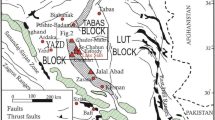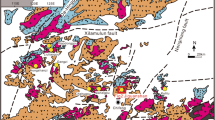Abstract
The Echo Bay stratovolcano complex and Contact Lake Belt of the Great Bear Magmatic Zone, Northwest Territories, host a series of coalescing Paleoproterozoic hydrothermal systems that affected an area of several hundred square kilometers. They were caused by intrusion of synvolcanic diorite–monzodioritic plutons into andesitic host rocks, producing several characteristic hydrothermal assemblages. They include early and proximal albite, magnetite–actinolite–apatite, and potassic (K-feldspar) alteration, followed by more distal hematite, phyllic (quartz–sericite–pyrite), and propylitic (chlorite–epidote–carbonate±sericite±albite±quartz) alteration, and finally by late-stage polymetallic epithermal veins. These alteration types are characteristic of iron oxide copper–gold deposits, however, with distal and lower-temperature assemblages similar to porphyry Cu systems. Magnetite–actinolite–apatite alteration formed from high temperature (up to 560 °C) fluids with average salinity of 12.8 wt% NaCl equivalent. The prograde propylitic and phyllic alteration stages are associated with fluids with temperatures varying from 80 to 430 °C and a wide salinity range (0.5–45.6 wt% NaCl equivalent). Similarly, wide fluid temperature (104–450 °C) and salinity (4.2–46.1 wt% NaCl equivalent) ranges are recorded for the phyllic alteration. This was followed by Cu–Ag–U–Zn–Co–Pb sulfarsenide mineralization in late-stage epithermal veins formed at shallow depths and temperatures from 270 °C to as low as 105 °C. The polymetallic veins precipitated from high salinity (mean 30 wt% NaCl equivalent) dense fluids (1.14 g/cm3) with a vapor pressure of 3.8 bars, typical of epithermal conditions. Fluid inclusion evidence indicates that mixed fluids with evolving physicochemical properties were responsible for the formation of the alteration assemblages and mineralization at Mag Hill. An early high temperature, moderate salinity, and magmatic fluid was subsequently modified variably by boiling, mixing with cooler low-salinity meteoric water, and simple cooling. The evidence is consistent with emplacement of the source plutons and stocks into an epithermal environment within ~1 km of surface. This generated near-surface high-temperature alteration in a dynamic hydrothermal system that collapsed (telescoped) resulting in widespread evidence of boiling and epithermal mineralization superimposed on earlier stages of alteration.













Similar content being viewed by others
References
Bastrakov EN, Skirrow RG, Davidson GJ (2007) Fluid Evolution and origins of iron oxide Cu-Au prospects in the Olympic Dam District, Gawler Craton, South Australia. Econ Geol 102:1415–1440
Camier J, Peshkepia A, Springer B, Mumin H (2007) Technical report on the Port Radium and Contact Lake 2006 summer drill projects, District of Mackenzie, Northwest Territories, Canada, volumes 1 to 4. Alberta Star Development Corporation, 134 pp plus appendices
Corriveau L, Williams PJ, Mumin AH (2010) Alteration vectors to IOCG mineralization: from uncharted terranes to deposits. In: Corriveau L, Mumin AH (eds) Exploring for iron oxide copper–gold deposits: Canada and Global Analogues. Geological Association of Canada Short Course Notes 20: 89–110
Eldridge CS, Danti K (1994) Low sulfur isotope ratios; high gold values—a closer look at the Olympic Dam Deposit via SHRIMP. Geol Soc Am, Abstr Programs 26:489–490
Gandhi SS, Mortensen JK, Prasad N, van Breemen O (2001) Magmatic evolution of the southern Great Bear continental arc, northwestern Canadian Shield: geochronological constraints. Can J Earth Sci 38:767–785
Gleeson SA, Smith MP (2009) The sources and evolution of mineralizing fluids in iron oxide–copper–gold systems, Norrbotten, Sweden: constraints from Br/Cl ratios and stable Cl isotopes of fluid inclusion leachates. Geochim Cosmochim Acta 73:5658–5672
Goad RE, Mumin AH, Duke NA, Neale KL, Mulligan DL (2000a) Geology of the Proterozoic iron oxide-hosted NICO cobalt-gold-bismuth, and Sue Dianne copper-silver deposits, southern Great Bear Magmatic Zone, Northwest Territories, Canada. In: Porter TM (ed) Hydrothermal iron oxide copper-gold and related deposits: a global perspective. Australian Mineral Foundation 1: 249–267
Goad RE, Mumin AH, Duke NA, Neale KL, Mulligan DL, Camier WJ (2000b) The NICO and Sue-Dianne Proterozoic, iron oxide-hosted, polymetallic deposits, Northwest Territories: application of the Olympic Dam model in exploration. Explor Min Geol 9:123–140
Gow PA, Wall VJ, Oliver NS, Valenta RK (1994) Proterozoic iron oxide (Cu-U-Au-REE) deposits: further evidence of hydrothermal origins. Geology 22:633–636
Haas JL Jr (1971) The effect of salinity on the maximum thermal gradient of a hydrothermal system at hydrostatic pressure. Econ Geol 66:940–946
Hilderbrand RS (1982) A continental volcanic arc of early Proterozoic age at Great Bear Lake, Northwest Territories. PhD thesis, Memorial University of Newfoundland, 240 pp
Hildebrand RS (1983) Geology, Echo Bay–MacAlpine Channel area, district of Mackenzie, Northwest Territories: Geological Survey Canada, Map 1546A, scale 1:50,000
Hildebrand RS (1984) Geology of the Camsell, River-Conjuror Bay area, Northwest Territories: Early Proterozoic cauldrons, stratovolcanoes and subvolcanic plutons. Geological Survey of Canada Paper 83–20, 42 pp
Hildebrand RS (1986) Kiruna-type deposits: their relationship to intermediate subvolcanic plutons in the Great Bear magmatic zone, northwest Canada. Econ Geol 81:640–659
Hildebrand RS, Hoffman PF, Bowring SA (1987) Tectonomagmatic evolution of the 1.9 Ga Great Bear magmatic zone, Wopmay orogen, northwestern Canada. J Volcanol Geotherm Res 32:99–118
Hildebrand RS, Hoffman PF, Bowring SA (2010) The Calderian orogeny in Wopmay orogen (1.9 Ga), northwestern Canadian Shield. Geol Soc Am Bull 122:794–814. doi:10.1130/B26521.1
Hoffman PF (1980) Wopmay orogen: a Wilson cycle of early Proterozoic age in the northwest of the Canadian Shield. In: Strangway DW (ed). The continental crust and its mineral deposits. Geological Association of Canada Special Paper 20, 523–549
Hoffman PF, Bell I, Tirrul R (1975) Volcanism and plutonism, Sloan River map-area (86K), Great Bear Lake, District of Mackenzie: in report of activities, part A. Geol Surv Can Pap 75(1A):331–337
Hoffman PF, McGlynn JC (1977) Great Bear Batholith: a volcano-plutonic depression. In: Baragar WRA, Coleman LC, Hall JM (eds). Volcanic regimes in Canada. Geological Association of Canada Special Paper 16: 170–192
Jackson VA, van Breeman O. Ootes L, Bleeker W, Bennett V, Davis WJ, Ketchum JWF, Smar L (2013) U-Pb zircon ages and field relationships of Archean basement and Paleoproterozoic intrusions, south-central Wopmay Orogen, NWT: implications for tectonic assignments. Can J Earth Sci. doi:10.1139/cjes-2013-0046
Johnson JP, McCulloch MT (1995) Sources of mineralizing fluids for the Olympic Dam deposit (South Australia): Sm-Nd isotopic constraints. Chem Geol 121:177–199
Mark G, Foster DRW (2000) Magmatic albite-actinolite-apatite-rich rocks from the Cloncurry district, Northwest Queensland, Australia. Lithos 51:223–245
McLelland J, Morrison J, Selleck B, Cunningham B, Olson C, Schmidt K (2002) Hydrothermal alteration of late- to post-tectonic Lyon Mountain granitic gneiss, Adirondack Mountains, New York: origin of quartz-sillimanite segregations, quartzalbite lithologies, and associated Kiruna-type low-Ti Fe-oxide deposits. J Metamorph Geol 20:175–190
Mumin AH (2006) Mineral potential of the Contact Lake belt. Unpublished technical report on 2005 exploration in the Contact Lake belt, Great Bear Magmatic Zone IOCG project, NWT, Canada. 233 pp
Mumin AH, Corriveau L, Somarin AK, Ootes L (2007) IOCG-type polymetallic mineralization in the Contact Lake Belt, Great Bear Magmatic Zone, Northwest Territories. Explor Min Geol 16:187–208
Mumin AH, Somarin AK, Jones B, Corriveau L, Ootes L, Camier WJ (2010) The IOCG-porphyry-epithermal continuum of deposits types in the Great Bear Magmatic Zone, Northwest Territories, Canada. In: Corriveau L, Mumin AH (eds) Exploring for Iron Oxide Copper-Gold Deposits: Canada and Global Analogues. Geological Association of Canada Short Course Notes 20: 57–76
Mumin AH, Phillips A, Katsuragi CJ, Mumin A, Ivanov G (2013) Geotectonic interpretation of the Echo Bay stratovolcano complex, northern Great Bear magmatic zone, Northwest Territories; Northwest Territories Geoscience Office, NWT Open File 2013–01
Muntean JL, Einaudi M (2000) Porphyry gold deposits of the Refugio district, Maricunga Belt, Northern Chile. Econ Geol 95:1445–1472
Peters WC (1987) Exploration and mining geology, 2nd edn. Broun-Brumfield Inc., USA, 685 pp
Porter TM (2010) Current understanding of iron oxide associated-alkali altered mineralised systems: part I, an overview, part II, a review. In: Porter TM (ed) Hydrothermal iron oxide copper–gold and related deposits: a global perspective—advances in the understanding of IOCG deposits, vol 3. PGC Publishing, Adelaide, pp 5–107
Pudack C, Halter WE, Heinrich CA, Pettke T (2009) Evolution of magmatic vapor to gold-rich epithermal liquid: the porphyry to epithermal transition at Nevados de Famatina, Northwest Argentina. Econ Geol 104:449–477
Reardon NC (1992a) Magmatic-hydrothermal systems and associated magnetite-apatite-actinolite deposits, Echo Bay, Northwest Territories. MSc thesis, University of Ottawa, 154 pp
Reardon NC (1992b) Altered rocks associated with the Mystery Island Intrusive Suite, Echo Bay, Northwest Territories. Geological Survey of Canada, Open File 2507, map scale 1:25,000
Reynolds LJ (2001) Geology of the Olympic Dam Cu-U-Au-Ag-REE deposit. MESA J 23:4–11
Richards JP (2011) Magmatic to hydrothermal metal fluxes in convergent and collided margins. Ore Geol Rev 40:1–26
Robinson BW, Ohmoto H (1973) Mineralogy, fluid inclusion, and stable isotopes of the Echo Bay U-Ni-Ag-Cu deposits, Northwest Territories, Canada. Econ Geol 68:635–656
Roedder E (1971) Fluid inclusion studies on the porphyry-type ore deposits at Bingham, Utah, Butte, Montana, and Climax, Colorado. Econ Geol 66:98–120
Roedder E (1984) Fluid inclusions. Mineralogical Society of America, Reviews in Mineralogy 12, 644 pp
Seo JH, Guillong M, Aerts M, Zajacz Z, Heinrich CA (2011) Microanalysis of S, Cl, and Br in fluid inclusions by LA-ICP-MS. Chem Geol 284:35–44
Schreiber DW, Fontbote L, Lochmann D (1990) Geologic setting, paragenesis and petrochemistry of gold quartz veins hosted by plutonic rocks in the Pataz region. Econ Geol 85:1328–1347
Sillitoe RH (1973) The tops and bottoms of porphyry Cu deposits. Econ Geol 68:799–815
Sillitoe RH (2010) Porphyry copper systems. Econ Geol 105:3–41
Skirrow RG, Bastrakov EN, Barovich K, Fraser GL, Creaser RA, Fanning CM, Raymond OL, Davidson GJ (2007) Timing of iron oxide Cu-Au-(U) hydrothermal activity and Nd isotope constraints on metal sources in the Gawler Craton, South Australia. Econ Geol 102:1441–1470
Smith MP, Gleeson SA, Yardley BWD (2013) Hydrothermal fluid evolution and metal transport in the Kiruna District, Sweden: contrasting metal behaviour in aqueous and aqueous–carbonic brines. Geochim Cosmochim Acta 102:89–112
Somarin AK, Mumin AH (2012) The Paleo-Proterozoic high heat production Richardson Granite, Great Bear Magmatic Zone, Northwest Territories, Canada: source of U for port radium? Resour Geol 62:227–242
Wanhainen C, Broman C, Martinsson O (2003) The Aitik Cu–Au–Ag deposit in northern Sweden: a product of high salinity fluids. Miner Deposita 38:715–726
Wanhainena C, Bromanb C, Martinssona O, Magnorc B (2012) Modification of a Palaeoproterozoic porphyry-like system: Integration of structural, geochemical, petrographic, and fluid inclusion data from the Aitik Cu–Au–Ag deposit, northern Sweden. Ore Geol Rev 48:306–331
Williams PJ, Barton MD, Fontboté L, de Haller A, Johnson DA, Mark G, Marschik R, Oliver NHS (2005) Iron-oxide-copper-gold deposits: geology, space-time distribution, and possible modes of origin. Economic Geology 100th Anniversary Volume: 371–406
Williams PJ (2010) Magnetite-group IOCGs with special reference to Cloncurry and northern Sweden: setting, alteration, deposit characteristics, fluid sources, and their relationship to apatite-rich iron ores. In: Corriveau L, Mumin AH (eds). Exploring for iron oxide copper-gold deposits: Canada and global analogues. Geological Association of Canada Short Course Notes 20: 13–22
Xavier RP, Monteiro LVS, Souza Filho CR, Torresi I, Carvalho ER, Dreher AM, Wiedenbeck M, Trumbull RB, Pestilho ALS, Moreto CPN (2010) The iron oxide copper-gold deposits of the Carajas Mineral Province, Brazil: an updated and critical review. In: Porter TM (ed) Hydrothermal iron oxide copper-gold and related deposits: a global perspective—advances in the understanding of IOCG deposits, vol 3. PGC Publishing, Adelaide, pp 285–306
Acknowledgments
This study is based on field and laboratory studies carried out at Echo Bay, NWT and at Brandon University, Canada, respectively. The project was funded by a BURC grant from Brandon University. Access to geological information, logistical, and technical support was provided by Alberta Star Development Corporation. The authors wish to acknowledge the support of staff from the Research Office at Brandon University. We thank L. Corriveau, R.S. Hildebrand, D.R. Lentz, R. Xavier, P. Williams, and an anonymous reviewer for their helpful comments.
Author information
Authors and Affiliations
Corresponding author
Additional information
Editorial handling: R. Xavier
Rights and permissions
About this article
Cite this article
Somarin, A.K., Mumin, A.H. P–T composition and evolution of paleofluids in the Paleoproterozoic Mag Hill IOCG system, Contact Lake belt, Northwest Territories, Canada. Miner Deposita 49, 199–215 (2014). https://doi.org/10.1007/s00126-013-0482-3
Received:
Accepted:
Published:
Issue Date:
DOI: https://doi.org/10.1007/s00126-013-0482-3




